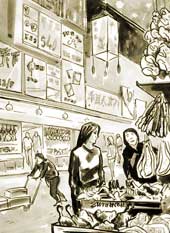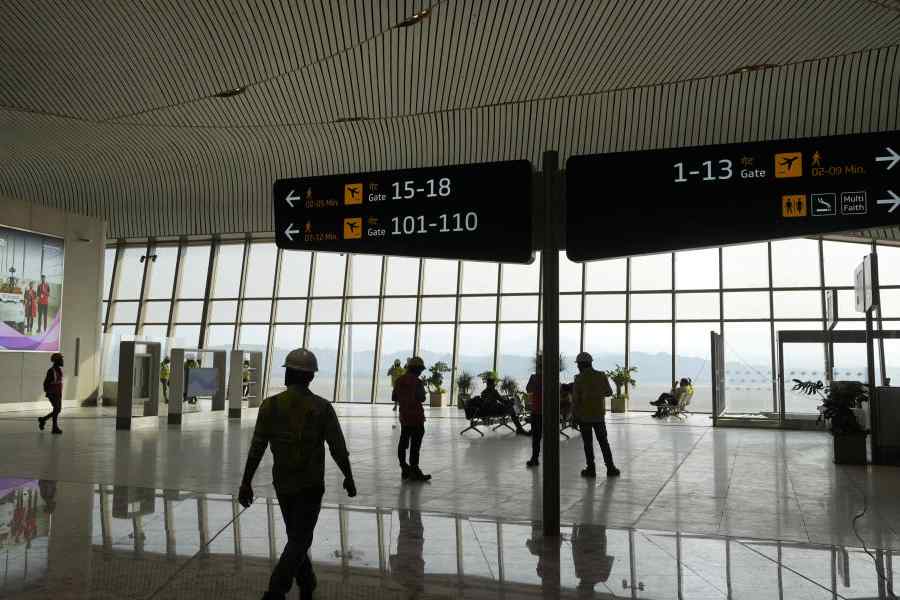 |
Central Hong Kong by night is a dense mass of brilliantly lit skyscrapers and blazing neons. It is the kind of night sky that deserves an undivided five minutes of attention before I go back to inspecting our room on the 28th floor of a hotel that sits regally at the very edge of Victoria Harbour.
Hotel rooms, specifically the regular rooms in luxury hotels, are fascinating places. After inspecting the bed linen, checking out the size of the monogrammed laundry bags, poking through the ridiculously-priced minibar with its sorry beer and nut selection and locating the always cleverly-hidden hair drier and electric kettle, I am ready to study the hotel service manual. A very nice thick black leather-bound book, with creamy gold-flecked, gilt-edged pages and prices that explain how the very nice leather-bound books recover their printing costs.
On its breakfast card the hotel offers a Chinese ? sanitised ? breakfast. For a glimpse into the secrets of real Chinese cuisine, with all the authentic colour, smells and sounds, a visit to any of Hong Kong?s bustling food markets is absolutely essential. All these markets start early, are fairly cheap and the only requirements are a strong gut and an open mind. Fortify yourself with large quantities of both if you decide to visit the Central Market, Hong Kong?s largest covered market.
Even if you are familiar with the interiors of Calcutta?s stomach-churning meat and fish markets, Central Market is a grisly experience. Grossness abounds in the overwhelming smell of meat, fish, animal innards, blood and open drains. A kindly taxi-driver guide suggested avoiding the chicken slaughter area but then went on to explain how every part of the chicken is carefully cleaned and utilised ? including the blood that is cooked slowly to make a kind of Chinese blood pudding.
In the dried food stalls around Wan Chai (central Hong Kong) you can find some of Chinese cuisine?s most valued ingredients. A particularly unidentifiable greyish substance turned out to be ?pork scratchings? ? slabs of dried pig skin, marinated and then cooked down to an almost vegetable-like substance. Sea cucumbers and shredded jellyfish are other delicacies. Eggs, not the usual white or brown ones that go into omelettes and cakes, but so-called 100-year-old duck eggs, are sold in most of these shops and stalls. These eggs are sold still covered in the mud that they had been supposedly buried in to absorb the salt from the soil which is said to enrich their yolk. The taxi-driver couldn?t tell whether the eggs really were a 100 years old. ?I think eggs old,? was all he could say wisely.
Once you are over the blood and gore (you don?t even need to see it really, I did so out of sheer curiosity) Hong Kong has plenty of street food places where you can eat really excellent food ? without the grossness. The eateries in the Stanley village market are good stops. At one of them, wooden tables and benches are set up in a large room that looks into a noisy, hot kitchen. Menus are in Chinese and English, prices are reasonable. For around 30 Hong Kong dollars you can get a steaming plate of crispy egg noodles topped with spicy fried pork and Chinese cabbage. The bamboo chopsticks and Oolong tea are on the house.
The Stanley village market is one of Hong Kong?s best known flea markets ? the other interesting ones are Cat Street market with its rows of antique shops (be warned, though, most sell clever fakes) and Jade market, with its little and big jade figurines, ornaments and other jade knick-knacks. Stanley market is a labyrinth of tiny shops and stalls selling everything from silk innerwear to dark wood chests and cabinets, to strappy lime green shoes and wind-up toys. Everything that China?s massive labour force mass-produces and sells around the world at below-the-competition prices.
I had been told to ?haggle fiercely? at Stanley village but with no one around to keep an eye on me, I limited my fierceness to happily accepting every deal every persuasive shopkeeper suggested to me: ?Buy two sets of my sheets and I give you five per cent off,? ordered a fat Chinese woman who was selling luxurious sets of silk linen. I did just that but with no calculator on hand I wasn?t quite sure if she did give me that five per cent off. ?Two skirts no change in price, four skirts big change,? grinned another man through a row of broken front teeth... and on it went for most of the four hours I spent at the village.
The bus ride down from Stanley village (located in the south of the island) to central Hong Kong was long and enchanting. Place names are a persistent reminder of Hong Kong?s days as a British colony ? Wellington Street, Queen Victoria Street, Lambeth Walk and Drake Street mix easily with Yee Woo Street, Tung Lo Wan Road and Tai Hang Road. As the bus drove down in the direction of Harbour Road and my hotel, not unlike sections of south Mumbai, we passed golf clubs with clipped front lawns and old white-washed bungalows with names like The Grove and Sea Breeze Villa. As we approached central Hong Kong, washed clothes flapped in the afternoon breeze from makeshift clotheslines across balconies of the dull-yellow and grey, many-storeyed apartment blocks where the majority of Hong Kong?s seven million people live.
The early evening view from my 28th-floor hotel room is of a very peaceful Victoria Harbour ? dotted with tiny little boats and bigger glamorous cruise liners ? ringed by the towering, claustrophobically close skyscrapers. The Star Ferry runs a round-trip service from Queen?s Pier in central Hong Kong across to Kowloon. The last ferry makes the trip some time around 10.30 pm. We get down to the pier in time for the last run. Western tourists, young Hong Kong couples, visitors from mainland China and office workers queue up with us for tickets. We sit towards the end of the gently rocking ferry with its faintly musty wooden odour. The water laps quietly around us and as the ferry moves out into the water, Hong Kong gives us a glittering farewell. Kowloon ? across the harbour ? is more sedate in its welcome. It is, after all, the gateway to mainland China.











